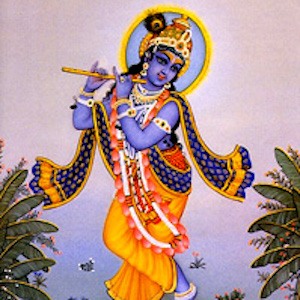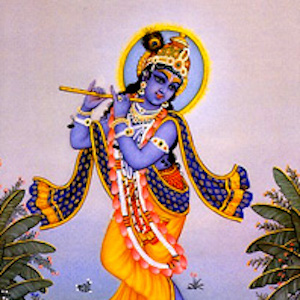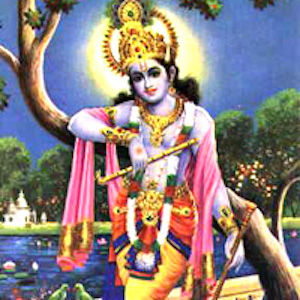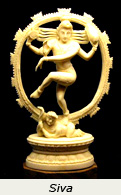Long Teaching Module: Bhakti Poets
Overview
This teaching module outlines the Bhakti Movement - a Hindu religious movement originating in the 6th century CE that was inspired by a number of prominent women poets. The module contains an essay that provides an overview of history and significance of the Bhakti and a number of images and samples of Bhakti poetry. The primary sources referenced in this module can be viewed in the Primary Sources folder below. Click on the images or text for more information about the source.
This long teaching module includes an informational essay, objectives, activities, discussion questions, potential adaptations, guidance on engaging with the sources, and essay prompts relating to the nine primary sources.
Essay
What is today known as the Bhakti Movement had its genesis in the South of India in the 6th century CE. It is characterized by the writings of its poet-saints, many of whom were female, that extolled passionate devotional love for the Divine. The Bhakti Movement gained momentum from the 12th centuries in the central western regions of India, then moved northward, coming to an end roughly in the 17th century.
The Hindu tradition has generally been divided into a number of important historical and religious periods through its long development. The formative time frame from 2500–400 BCE is highlighted by what are known as the sacred texts, the Vedas, and a nomadic people known as the Indo-Aryans; this period is classified as the Vedic Period. Central to the Vedas was the visionary figure of the rishi, or seer, one who was able to communicate with and about the various gods of the Vedic pantheon through a complex system of rituals that could only be conducted by an increasingly powerful priesthood. Liberation, or moksha, was to be found through the precise performance of ritual.
The Epic and Classical Periods, from 400 BCE–600 CE are so named because of their focus on important texts, namely, the Mahabharata and the Ramayana. These epics are concerned with heroes and heroic battles, kings, queens, and ideal roles of individuals. Also of central importance to this time frame were Law Books concerned with the ideal nature of society. Social order and stability were to be found in a hierarchical ordering of people as well as specific roles assigned to each individual’s life stage (ashrama) and position in society (varna) or caste. On the upper rung of this system was the Brahmin priesthood, followed by Kshatriyas (warriors) and Vaishyas (merchants), also known as twice-born classes. Only these groups were enabled to take part in an initiation ceremony known as the “sacred thread,” study the Vedas, and take part in Vedic rituals. Beneath these three groups were the Shudras, those who were servants to the upper three varnas. Underneath this rung came another subsection, the Untouchables, those whose occupations were so polluting that they did not even qualify to fit within an ordered society. The way to liberation from rebirth or moksha was in a true understanding of dharma, recognition and maintenance of the good of the social order, as exemplified and regulated by the Epics and Law Books.
The Medieval Period followed, of which the Bhakti Movement was an integral aspect. This was due in part to the rise of a new line of kings, the Gupta lineage (320 CE) that supported the pantheon of gods through worship of divine images (puja) and also included the building of temples and support for devotional groups. Alongside these developments came a flourishing of mythical compositions about the gods, known as the Puranas, or, “ancient stories.” Central to this pantheon were the gods Vishnu, the cosmic king, and Shiva, the great yogi and ascetic known by many names, and his feminine counterpart, Shakti, or divine energy. Shakti was worshipped both as wife and consort of Shiva, but also in her own right as the Great Goddess in a variety of manifestations.
Most Hindus, today, identify themselves with the worship of one of these gods. Devotees of Vishnu in his many incarnations—known as avatars, Krishna and Rama being the most popular manifestations—are called Vaishnavites. Those worshiping Shiva are known as Shaivites, whereas followers of the feminine divine are Shaktas. Devotees within each strand focus on their god or goddess as Ultimate Reality, thus having a distinctly monotheistic outlook, while at the same time acknowledging that the Divine takes many forms for the benefit of humanity.
Primary Sources
Teaching Strategies
Selections from the poetry from the Bhakti movement were chosen to cover and portray a wide variety of female experience, writing styles, attitudes, and subjectivity within a highly patriarchal society. It is recommended that students initially read the overview on the Bhakti movement, then focus on the section on women within the movement, so that the actual primary sources are somewhat contextualized.
Read the poetry out loud! These women wrote out of sheer desperation, out of sheer abandon and utter devotion. The depth of their emotion can best be “heard” in actually reading their words out loud.
Focus on the images utilized by these poet-saints. It is not the esoteric imagery of the learned that is portrayed in these poems. It is the imagery of the everyday, grounded realities of women in medieval India that so vividly comes to the fore. Utilize the poetry to examine women’s realities, and focus on how varied those experiences were for women, without losing sight of their subjectivity as women.
Discussion Questions:
- In reading the poetry from the female bhaktas, focus on the imagery utilized by them. Is it “other-worldly?” Is it “this-worldly,” focused on everyday realities?
- Many of these poems emphasis women’s relationships—with their husbands, with their in-laws. Why do you think this is the case?
- There is a great deal of diversity within the poetry and the actual experiences of female bhaktas in terms of the extent that they challenged the patriarchal system surrounding them. Discuss.
- The poet-saints often used wedding imagery, or even sexual images in portraying their love and devotion to the Divine. Why?
Lesson Plan
Time Estimated
Approximately three 45-minute class periods and one additional day for writing the DBQ.
Objectives
After completing this lesson, students will be able to:
- describe examples of passionate devotion expressed in bhakti poetry.
- explain how bhakti poetry illustrates both inner (personal) and outer (social) conflicts experienced by devotees.
- evaluate the decision made by bhakti poets to defy social convention in order to pursue their passionate relationship with their Lord.
Materials
- Sufficient copies of the following sources (in this sequence):
- Colored paper or construction paper
- Plain white paper
- Colored pencils or markers
- Sufficient copies of the poem structure for Activity 4
Source 4: Poem, Mirabai 3
Source 6: Poem, Akkamahadevi
Source 5: Poem, Mirabai 4
Source 3: Poem, Mirabai 2
Source 8: Poem, Bahinabai
Source 1: Poem, Janabai
Source 2: Poem, Mirabai
Source 7: Poem, Akkamahadevi 2
Source 9: Poem, Bahinabai 2
Strategies
- Prerequisite knowledge: Students should be familiar with Hinduism, with the identity of the gods Vishnu and Siva, and with the avatar of Vishnu Krishna. Explain to students that the gods Krishna and Siva have several names, some of which are used in the poems studied in this module (e.g., “Mountain Lifter” and “Lord White as Jasmine”). Ensure students are also familiar with conventions of modesty and marriage in India in the period under consideration.
- Hook: Ask students to describe God as represented in the Judeo-Christian-Muslim tradition. They may describe God as an old man with a beard who sits on a throne in heaven, as a “father,” or as one who grants blessings, performs miracles, or distributes punishment. Then ask students to imagine their ideal boyfriend or girlfriend. What would he or she be like? Finally, ask students to meld the two ideas in their minds. What if they were to seek love with God instead of with a human partner? Students may react with a variety of emotions such as disgust, shock, or curiosity. Explain to students that “bhakti” means devotion or love. Bhakti poets expressed a yearning for passionate union with a deity. However, such desire often carried a high price as poets and devotees defied social convention in order to embrace their love for and with the divine.
- Distribute copies of Source 4: Poem, Mirabai 3 to students. Have a student read the poem out loud. Ask students to discuss their initial impression of the poem. For whom does the poet long? Why does she defiantly tell the country doctor to go away? Have another student read the same poem out loud, instructing students to listen for phrases that express the poet’s desire to be united with the divine. Have students underline these phrases. Then ask students to circle phrases or images that express the poet’s pain.
Distribute copies of Source 6: Poem, Akkamahadevi. Repeat the same study of this poem. Give students sheets of colored paper and colored pencils or markers. Instruct them to write the word “bhakti” in the center of the page. Using the pencils or markers, students should copy onto their papers phrases from Source 4: Poem, Mirabai 3 and Source 6: Poem, Akkamahadevi that describe the poets’ passion and pain. - Provide students with copies of Source 5: Poem, Mirabai 4. Have a student read the poem out loud. Ask students to explain the actions described by the poem. Then ask students to study the poem for literary evidence of Mirabai’s passion. Finally, what lines in the poem indicate the ways Mirabai was viewed and treated by others? Assign students to emulate the poem by writing a poem of their own using this poem structure handout.
- Arrange students in small groups. Provide each group with copies of Source 3: Poem, Mirabai 2. Instruct the students to read the poem and discuss the following questions among themselves:
To whom is this poem addressed?
What does the poem describe?
What details does the poet include?
What consequences might a woman experience if she chose marriage to her God rather than to a human man?
Have groups share their thoughts with the whole class. Distribute white paper and colored pencils or markers to each group. Instruct each group to illustrate the poem and write a toast for Mirabai to be made at her wedding to the Lord. - Students may remain in the small groups created for Activity 5. Distribute copies of Source 8: Poem, Bahinabai to each group. Explain that the Vedas are a body of ancient Indian literature that includes myths, hymns, and rules for worship and social conduct. Instruct students to read the poem and identify the primary conflict this poet experiences (between her desire for devotion to God and her responsibility as a wife). Invite students to interpret the image of the hissing serpent. Who or what might the great serpent be? Discuss.
Instruct each group to think of other examples from their study of literature or history in which women have made unconventional choices, rejecting marriage and family in order to follow other passions or pursuits. What positive and negative consequences have these women experienced? Discuss.
- Give each group copies of one of the following: Source 1: Poem, Janabai, Source 2: Poem, Mirabai, or Source 7: Poem, Akkamahadevi 2. Assign groups to read the poems and discuss the following questions:
In Source 1, how does Janabai defy social convention? How does she express her defiance? Why does she call herself a “slut?”
In Source 2, what conflicts does Mirabai describe? Are the battling in-laws or locked door metaphors? If so, what might they mean?
In Source 7, why does the poet wander naked? Why does she say she is “no woman?” What is her attitude toward men who would see her as a whore?
Using the blackboard or an overhead, have students share their thoughts and collect the results of student work on a summarizing the struggles and conflicts described by female bhakti poets. - Wrap up: Have students review their notes and other work completed as part of this lesson. Ask students to imagine and discuss the qualities of a woman who would pursue her spiritual devotion despite the profound criticism and even danger experienced by female bhakti poets. Should such women be compelled to give up their spiritual passion for their duties as wives and mothers?
As part of the concluding discussion, have students read Source 9: Poem, Bahinabai 2, in which Bahinabai reconciles her devotion with her domestic duties. Should women make such a compromise? Or should a society find ways to accommodate that intensity of devotion and worship, even when it takes women away from the home and their families? Ask students to support their point of view with evidence from the poems, or by drawing on their knowledge of literature or world history.
Differentiation
Advanced Students: Have students select one of the following options: (a) research and report on the biography of Mirabai; (b) compare and contrast a poem from the bhakti tradition with that of another devotional or mystical tradition (for example, that of Rumi); (c) write a devotional poem.
Less Advanced Students: Complete Activities 1, 2, 3, 4, 5, 6 as instructed. For Activity 7 choose Source 1: Poem, Janabai or Source 2: Poem, Mirabai to complete together as a whole class activity. Provide students with additional support in identifying supporting evidence in the poems. Make enlargements of the poems to display on an overhead projector. Demonstrate underlining and other annotations on the overheads. Prepare students to write the DBQ essay by deciding together what poems they might discuss as they address each bullet of the assignment. Outline the essay and consider permitting students to write the essay with the outline in front of them. Consider writing an introductory paragraph for the essay together as a class.
Document Based Question
Document Based Question (Suggested writing time: 40 minutes)
Directions: The following question is based on the documents included in this module. This question is designed to test your ability to work with and understand historical documents. Write an essay that:
- Has a relevant thesis and supports that thesis with evidence from the documents.
- Uses all or all but one of the documents.
- Analyzes the documents by grouping them in as many appropriate ways as possible. Does not simply summarize the documents individually.
- Takes into account both the sources of the documents and the authors' points of view.
You may refer to relevant historical information not mentioned in the documents.
Question: Drawing on specific examples from the poems studied in this module, write a well organized essay of at least five paragraphs in which you:
- Describe the spiritual yearning and passion experienced by devotees
- Explain conflicts experienced by devotees between their spiritual passion and their social obligations and responsibilities
- Evaluate the decision made by women who chose devotion over conventional responsibilities and duties
Be sure to analyze point of view in at least three documents or images.
What additional sources, types of documents, or information would you need to have a more complete view of this topic?
Bibliography
Original Sources: Introductions, Translations
Websites
Other Women's Voices: Translations of women's writing before 1700: Akka Mahadevi /Mahadeviyakka (1100s)
Dorothy Disse
http://home.infionline.net/~ddisse/mahadevi.html#anchor186952
An extensive website devoted to women’s voices, pre-1700s from around the world, including a selection of Akka Mahadevi’s poetry in the Tamil language from South India.
Other Women's Voices: Translations of women's writing before 1700: Antal/ Andal/ Goda /Kotai (mid-800s?)
Dorothy Disse
http://home.infionline.net/~ddisse/antal.html
An extensive website devoted to women’s voices, pre-1700s from around the world, including a selection of Antal’s writings in the Kannada language from India.
Sri Vaishnava Home Page
Mani Varadarajan
http://www.ramanuja.org/sv/alvars/andal/
A website devoted to Vaishnavism, a dominant strain within Hinduism. Andal was one of the Alvar Saints of South India.
Sri Vaishnava Home Page
Mani Varadarajan
http://www.ramanuja.org/sv/alvars/andal/tiruppavai/verse1.html
"Tiruppavai" (Andal’s first work), here presented in both the Kannada language and English literal translation.
[tamil] tiruppavai and Tiruvempavai – English, "Dr.N.Ramani"
Tamil.net
http://www.tamil.net/list/2000-12/frm00575.html
This email, part of a larger discussion from Tamil.net, focuses on Andal’s poetry, including her poems "Thiruppavai," "Thiruvempavai," and "Thiruppalliyelucci," translated from Kannada by N. Ramani.
Other Women's Voices: Translations of women's writing before 1700: Mirabai /Mira /Meera (c.1498-aft.1550)
Dorothy Disse
http://home.infionline.net/~ddisse/mirabai.html
An extensive website devoted to women’s voices, pre-1700s from around the world, including a selection of Mirabai’s poetry in English, originally from the Gujarati language.
Madhu Kishwar, “Traditional Female Moral Exemplars in India.”
The Infinity Foundation
http://www.infinityfoundation.com/mandala/s_es/s_es_kishw_EAA.htm
An excellent article by Madhu Kishwar, Senior Fellow at the Center for the Study of Developing Societies in Delhi, India, and founding editor of Manushi—A Journal about Women and Society from India. This article focuses on female “moral exemplars” or “role models” from within the Hindu tradition, from the divine feminine creative energy known as “shakti,” village goddesses, Pan-Indian goddesses (devis) such as Parvati, Sita, and Durga, as well as bhakti poets, including Mirabai (spelled Meerabai in this article) and Antal (here spelled Andal).
Credits
About the Author
Doris Jakobsh is an Instructor of Religious Studies at the University of Waterloo in Canada. She is author of Relocating Gender in Sikh History: Transformation, Meaning and Identity and has been awarded fellowships and awards from Harvard University, the University of British Columbia, and the Social Sciences and Humanities Research Council of Canada. In 2002, she was nominated for the “Excellence in Teaching with Technology Award” from Wilfrid Laurier University for her work with distance education in “Asian Spiritual Disciplines.”
About the Lesson Plan Author
Elizabeth Ten Dyke teaches 9th- and 10th-grade Global History and Geography at Kingston High School in Kingston, New York. In the past she has also taught secondary sociology, psychology, and AP Human Geography, as well as undergraduate and graduate courses in cultural anthropology. Trained as a cultural anthropologist, Dr. Ten Dyke is the author of Dresden: Paradoxes of Memory in History, published with Routledge in 2001. This study explores tensions and contradictions in social memory and historical understanding in the former German Democratic Republic during the post-socialist transition.
Grateful acknowledgement is made to the following institutions for primary sources:
- Penguin Books, Ltd., www.penguin.co.uk
- The Feminist Press, City University of New York
- Transcendental Art Gallery, HareKrsna.com
This teaching module was originally developed for the Women in World History project.






